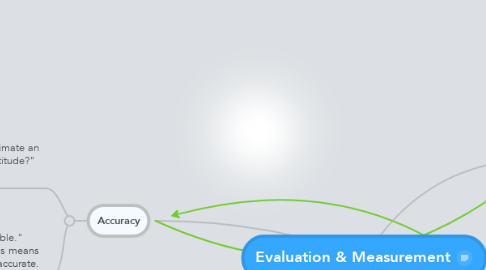Evaluation & Measurement
by Victoria Livsey


1. Accuracy
1.1. "Does the test score fairly closely approximate an individual's true leve of ability, skill, or aptitude?" (Kubiszyn & Borich, 2013, page 326)
1.2. "Most test scores are not perfectly reliable." (Kubiszyn & Borich, 2013, page 348) This means that a test score cannot be completely accurate.
1.2.1. Although no test can be 100% accurate, we can ensure a great deal of accuracy by verifying validity and testing reliability.
1.2.2. An obtained score may not be equivalent to an true score due to other factors which can include not getting a good night's sleep.
2. "To be a "good" test, a test ought to have adequate evidence for its validity, reliability, and accuracy for the purpose it is being used for and for the persons with whom it is being used." (Kubiszyn & Borich, 2013, page 326)
3. Validity
3.1. Research and time should be put into ensuring valid information and data used during evaluations and measurement.
3.1.1. Ensuring valid content protects against inaccurate testing results and scores.
3.2. "Does the test measure what is is supposed to measure?" (Kubiszyn & Borich, 2013, page 326)
4. Reliability
4.1. "Does the test yield the same or similar score rankings (all other factors being equal) consistently?" (Kubiszyn & Borich, 2013, page 326)
4.2. Reliability in testing is highly important to ensure fair and equal testing among students.
4.2.1. Test and Re-test can be used to determine reliability.

